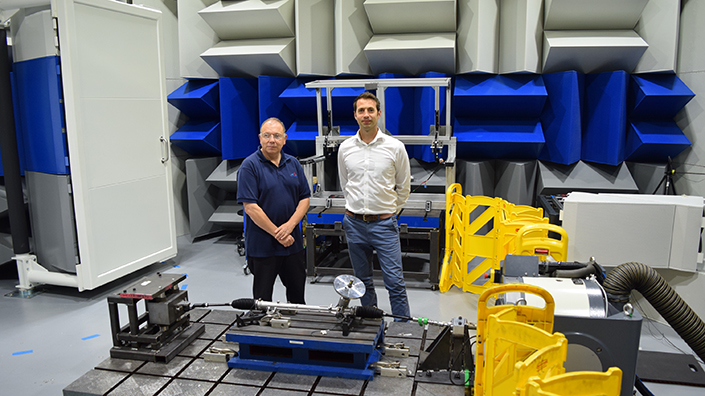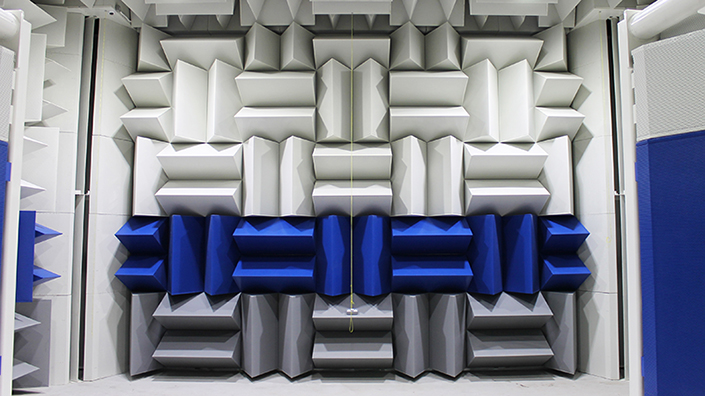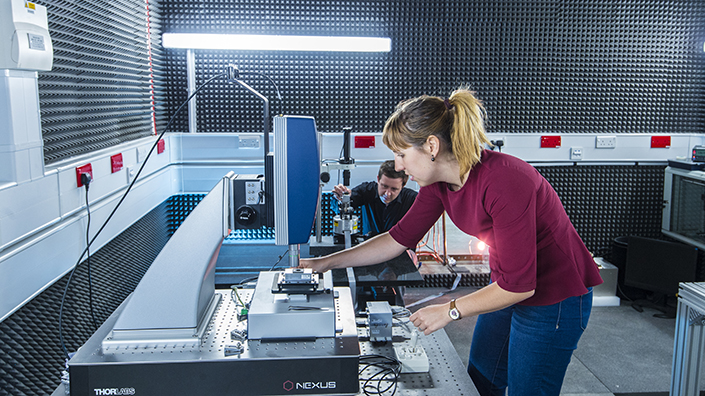It is very, very quiet. Silent, in fact, other than a slight ringing in my ears and a soft whistle from the nose of one of my guides, who is gently breathing several metres away from me.
The floor beneath my feet feels solid but is in fact ‘floating’, suspended on a giant dampener. All other surfaces in the 7 x 7 x 4.5m box are covered in metal cones that kill echoes, causing the unnatural quiet.
The room is an anechoic chamber at Saint-Gobain in Bristol, jokingly described as “one of the biggest companies no one’s ever heard of” by its global chassis leader Tom Francis. The multinational firm provides materials and parts across sectors including building, transport, industrial applications and infrastructure. The Bristol branch focuses on mobility, mainly automotive, supplying parts including bearings and tolerance rings.
Francis is joined by global chassis and powertrain manager Chris Needes and noise, vibration and harshness (NVH) leader Allan Robinson to show me around. We sit on deep, amphitheatre-style wooden steps in the airy lobby of the industrial estate facility as Francis sets out a key aspect of the company’s NVH work, centred around the chamber along the corridor.

Allan Robinson and Tom Francis in the Saint-Gobain chamber in Bristol
“If you’ve ever had a car with a squeak or a rattle in it, it’s one of the most irritating things in the world,” he says. Hidden noises can lose companies sales or become major annoyances for drivers and passengers. Despite the potential commercial impact, Francis says OEMs are “not sophisticated enough” to design for noise and vibration.
“What tends to happen is they’ll get through a certain point of the development phase, there’ll be a noise somewhere and all of a sudden you’ll have a team working on that particular noise to try and fix it.” As a result, they turn to facilities like the one at Saint-Gobain.
Wells of silence
After the tour introduction, we walk past open-plan areas and shiny whiteboards towards the heart of the building. From the outside, the chamber is a large grey cube, like a building contained within another building.
“As you can see it’s quite substantial,” says Francis. “This is the level we’re having to go to now so we can supply what the customer wants.”
Inside, cones cover the walls. The blue and white protrusions are filled with glass fibre, which absorbs sound energy and converts it to a small amount of heat. The cones cause a gradual change in impedance between the air and the material, stopping the reflection of sound waves down to 100Hz and leaving background noise of only about 20dB. While the ‘hemi-anechoic’ room in Bristol has the insulated concrete floor – one reflecting plane, like a road – fully anechoic rooms have cones on every surface and raised grilles for access.
Engineers plan and analyse tests from a monitor-filled control room. They also model parts’ resonant frequencies, a major cause of noise. Described as “high tonal whines” by NVH leader Robinson, they occur when the rotational order of an object combines with the mechanical frequency of a system. They also relate to other parameters including mass and damping.
Resonant frequencies
Through the thick door into the otherwise silent, echo-free chamber, there is a shaker that works like a large loudspeaker with a pumping diaphragm. Capable of generating forces up to 10kN, it vibrates through a wide range of frequencies with parts or even whole systems mounted on top. During my visit, a seat mount including rails and controls is on the device, which runs from a high frequency to a much lower one. The machine can vibrate front-to-back, side-to-side and up-and-down, and can even simulate the vibrations of real engines.
Engineers measure noise and vibration around systems during the tests, without all the environmental challenges of on-road measurement – running engines, rough road surfaces and horns would all introduce serious interference. The results are then analysed for resonant frequencies, and problem parts identified.
Once an issue is diagnosed, engineers can try a few different things. A thick grease could prevent rattle between parts. Saint-Gobain can introduce its own parts to OEM systems, such as a sprung ring with tuneable stiffness. 3D printers and laser cutters quickly build new parts, which can be swapped in before repeat tests. According to Robinson, new components can reduce system acceleration level by half when introduced in the right place.

The blue and white cones of Saint-Gobain's anechoic chamber absorb sound energy and kill echoes
After that, the modified systems go back into cars to see if the noise has disappeared in real-life conditions. The process does not always work, however – Francis says the Saint-Gobain team is “very often” caught in frustrating games of NVH whack-a-mole, replacing parts to prevent noises only for them to crop up elsewhere.
Even if the team eventually improves all the noises, there could be further issues. Test drivers often clash with the NVH team, says powertrain manager Chris Needes, as modifications introduced to stop noises can make the car less satisfying to drive. He gives the example of NVH wanting to add an O-ring into a steering-wheel column.
In cases like this, NVH and the ‘feel’ of a car are “absolutely against each other,” he says. Thankfully, the company uses its rapid prototyping and modelling capability to quickly produce tuned parts. “What we try to do now is to come up with components that give them the balance, so we can design a spring that fits into there that gives them the right noise performance but really doesn’t affect how it feels.”
Growing demand
The Bristol facility was built to house the chamber thanks to healthy demand for testing services, and Francis predicts future growth thanks to a strange side effect of the increasing number of pure electric cars.
“Internal combustion engines give you quite a broadband noise range that actually humans find OK, it’s quite pleasurable,” he says. “When you move to electric motors it’s kind of a very narrow band, higher-pitched noise that can really irritate you.”
This makes Saint-Gobain’s work all the more important. People buying electric cars expect less noise in their vehicles, but the technology can have the opposite effect. A key part of NVH is not just preventing sounds, but also making persistent noises more pleasant for the human ear.
For now, the biggest growth is cars with internal combustion engines and increased electrification. “We’re finding that, because of this increased complexity, individual components can have a big impact on system performance. We’re also seeing that, from the component perspective, we’re starting to hit the limit of what our traditional components can achieve.”
Looking ahead, the next major trend could lead to increased NVH scrutiny yet again. With no requirement for drivers, self-driving cars are expected to have much more flexible cabins – each of five seats might rotate for reconfigurable layouts, for example, introducing lots more moving parts and the potential rattles that come with them. People might take advantage of new set-ups to work or enjoy leisure activities in their vehicles, putting further pressure on NVH departments to prevent noise.
Quantum leap
Noise is a hassle for Saint-Gobain’s customers, and a potential annoyance for owners. Elsewhere, it is an enemy that must be defeated, and the measures to prevent it go beyond just sound.
In Lancaster, 200 miles from the Saint-Gobain Bristol facility, is the “world unique” IsoLab, “designed from the ground up to isolate the lab space from noise as much as possible,” according to Professor Rob Young. Insulated foundations and anechoic cones prevent vibrations in the facility’s three laboratories, which are each surrounded by 50-tonne ‘horseshoes’ of concrete. Faraday cages stop electromagnetic noise and most experiments are cooled to within “a hair’s breadth of absolute zero” (-273.15ºC), to limit thermal noise.
Lancaster University’s advanced new centre is designed to isolate measurements from noise as much as possible, to facilitate mainly new quantum technologies. Development includes devices to measure magnetic fields more sensitively than has been possible before, quantum security devices and materials for energy recovery or catalysis.

Noise is an 'enemy that must be defeated' at IsoLab
“We go to great lengths to isolate the signal from the noise, so we can measure the true behaviour of our quantum devices,” says Professor Young at the Royal Society. “The foe of measurement is noise. If you’re trying to measure something and you have noise, then it prevents you from measuring the finest detail.”
The laboratory is one of the quietest in the world and the university has gone to extreme lengths to isolate its work. But will IsoLab and more basic facilities like Saint-Gobain in Bristol always be required? Simulation becomes more advanced each year, and fast new computers make it more accessible.
“Modelling is getting better and better but it’s very, very time-consuming, especially if you’re looking at a full vehicle level, and there just isn’t resource to put into that at the moment,” says Francis. For now, he says, physical testing is the only way to be certain of a system’s performance.
“Until you put them all together and see how they interact with each other, you don’t really know what’s going to happen. And that’s why it’s important to do this kind of analysis. There is a problem, where’s it coming from, how can we fix it?”
He adds: “There will always, always be a requirement to test. Even if your simulation capabilities are good, you have to prove what you simulate.”
With ever-higher expectations for technology in our noise-polluted society, and increasing development of technology utilising quantum phenomena, more corners of the country will likely fall silent – or close enough.
Want the best engineering stories delivered straight to your inbox? The Professional Engineering newsletter gives you vital updates on the most cutting-edge engineering and exciting new job opportunities. To sign up, click here.
Content published by Professional Engineering does not necessarily represent the views of the Institution of Mechanical Engineers.